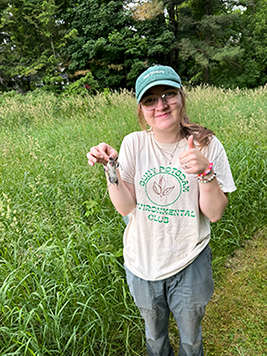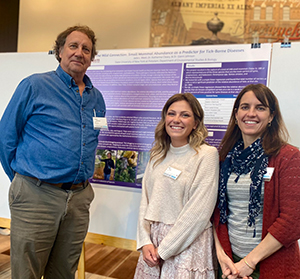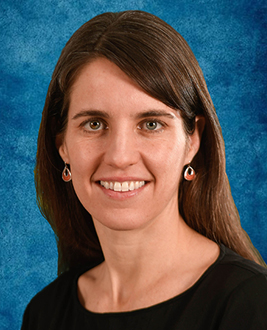 Faculty Bio
Faculty Bio
Katherine Cleary is a conservation biologist whose research focuses on evaluating the complex relationships between biodiversity and agriculture. She holds a B.S. in Biology from the University of Richmond, an M.S. in Conservation Biology from Colorado State University and a PhD in Conservation Genetics from the University of Idaho. Between these degrees, she served as a Peace Corps volunteer in Guatemala and a Fulbright Scholar in Costa Rica. She has also worked for the National Park Service, the US Geological Survey and private environmental consulting firms.
This Kilmer Lab has three ongoing projects:
- Project 1: Adirondack Inventory and Monitoring (AIM) Camera Trapping at SUNY Potsdam
- Project 2: Evaluating differences in biodiversity between mowed lawns and low-mow meadows on campus
- Project 3: Mammal Diversity, Populations, and Habitats along the Urban/ Rural Interface
You can find descriptions for these projects below.
Projects
Adirondack Inventory and Monitoring (AIM) Camera Trapping at SUNY Potsdam
The goal of this project is to use camera traps to inventory and monitor wildlife populations on the SUNY Potsdam campus and adjacent lands. This project is part of a larger regional effort, the Adirondack Inventory and Monitoring (AIM) network, which was launched in 2021 by Dr. Paul Jensen at SUNY ESF. AIM is the first effort to look at wildlife abundance and distributions across the entire Adirondacks and surrounding regions, and our findings will be used to inform wildlife management and conduct education and outreach at both local and regional scales.
This Kilmer Lab project is the first time Dr. Cleary has worked with camera traps to study wildlife. She is excited about the potential of camera traps to reveal patterns of wildlife movement we can't detect with any other approach.
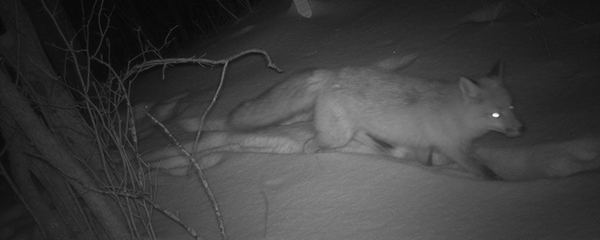
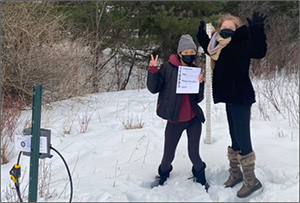 Students
Students
- Eileen Liew
- Yari Moran
Evaluating differences in biodiversity between mowed lawns and low-mow meadows on campus
Like many college campuses, our campus has a significant amount of land that is regularly mowed during the spring, summer, and fall. This mowing reduces habitat for native insect species, like monarch butterflies, that rely on plant resources to survive and reproduce. It also has a significant cost in labor time, fuel, and wear and tear on vehicles. While the campus has already designated several low mow zones on campus, we propose that even more areas be left on a low mow or no mow cycle. To quantify the effect this will have on biodiversity, we will measure plant and insect species diversity in mowed lawns and low mow meadows on campus. Our hypothesis is that low-mow meadows will show higher plant and insect species richness and diversity than the mowed lawn areas. Our long-term goal is to encourage facilities to include additional low-mow zones in future management plans, and to convince students and administration to support this change.
Students working on this project gain experience in ecological field work, including plant quadrat sampling and sweep netting for insects. Students learn how to identify a wide range of native and invasive plant and insect species, and how to analyze biodiversity data. I ask all my students to present at our campus Learning and Research Fair in the spring, and I encourage them to present at regional conferences too.
Students
- Sean Kousnetsov
- Mary Keating
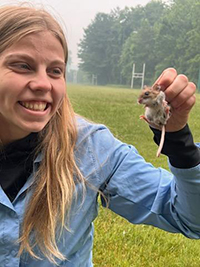 Mammal Diversity, Populations, and Habitats along the Urban/ Rural Interface
Mammal Diversity, Populations, and Habitats along the Urban/ Rural Interface
Most people have observed deer roaming across village lawns or are occasionally startled by a skunk in their backyard, but overall we tend to assume that in urban and suburban areas wildlife diversity is lower than in wildlands. However, this is not always the case! Previous studies have shown that some wildlife species are more common in human impacted areas, while other species do experience dramatic declines. Which species can thrive in and around developed areas affects both wildlife and humans, and has especial impact on health issues like the spread of tick-borne disease.
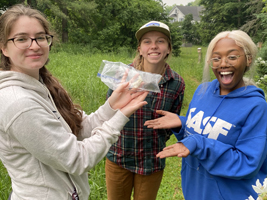 A team of SUNY Potsdam researchers including myself, Glenn Johnson, Bridget Amulike, and Jess Rogers are conducting a study to assess the diversity of wildlife species that are found in and around the rural-urban interface in Potsdam, NY, and the links between wildlife populations and tick-borne disease. The study involves using a combination of camera traps, pitfall traps, and a newly developed “bucket cam” to survey a representative group of mammals including 1) small mammals (rodents and shrews), 2) larger rodents and rabbits, 3) mesocarnivores (raccoons, fox, skunks) and 4) white-tailed deer.
A team of SUNY Potsdam researchers including myself, Glenn Johnson, Bridget Amulike, and Jess Rogers are conducting a study to assess the diversity of wildlife species that are found in and around the rural-urban interface in Potsdam, NY, and the links between wildlife populations and tick-borne disease. The study involves using a combination of camera traps, pitfall traps, and a newly developed “bucket cam” to survey a representative group of mammals including 1) small mammals (rodents and shrews), 2) larger rodents and rabbits, 3) mesocarnivores (raccoons, fox, skunks) and 4) white-tailed deer.
Students working on this project gain experience in wildlife study design, conservation on public and private lands, setting all kinds of mammal traps, and analyzing data from these different trap types. They also build skills working on an interdisciplinary research team made up of faculty and students from the Environmental Studies and Biology department.
Students
- McKensey Biggie
- Paige Brown
- Alyssa Card
- Annabell Smith-Gooden
- Sylvia Grant
- Lara Martin
- Caelin Ramsay
- Dan Spanneut
- Jada West
Kilmer Poster Presentation
Jada West (Environmental Studies, '24) recently attended the Northeast Natural History Conference in Albany, along with Dr. Kate Cleary and Dr. Glen Johnson. Jada was able to network with regional biologists and presented a poster on her Kilmer Lab research project, titled "The Wild Connection: Small Mammal Abundance as a Predictor for Tick-Borne Diseases".
Publication
Recently, Kate Cleary (Environment and Sustainability) published a paper with Bridget Amulike (Biology), Glenn Johnson (Biology), Jessica Pearson (Environment and Sustainability), and Vinny Bonaiuto, a student who graduated in '23. The paper details their field tests of the new BucketCam approach they designed to study small mammal populations for our research on mammals and tick-borne disease.
Cleary, K. A., Bonaiuto, V., Amulike, B., Pearson, J., & Johnson, G. (2025). A reduced labor, non-invasive method for characterizing small mammal communities. Mammal Research, 1-8.
LoCAL funding means that this project isn't just a one-off, but rather can continue year after year, contributing data to our larger partner network and providing many students with a unique hands-on field experience.
Assistant Professor, Department of Environmental Studies
Questions?
Students interested in participating in any of these projects can contact Katherine Cleary at clearyka@potsdam.edu or (315) 267-2566.

